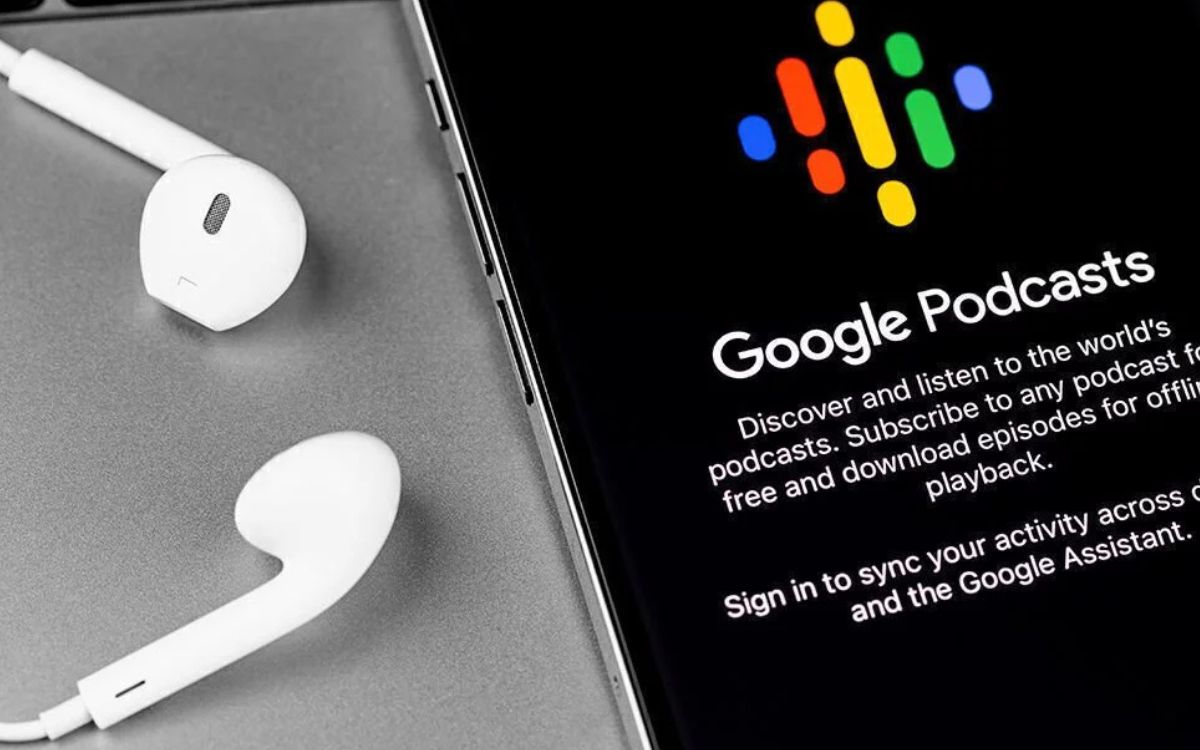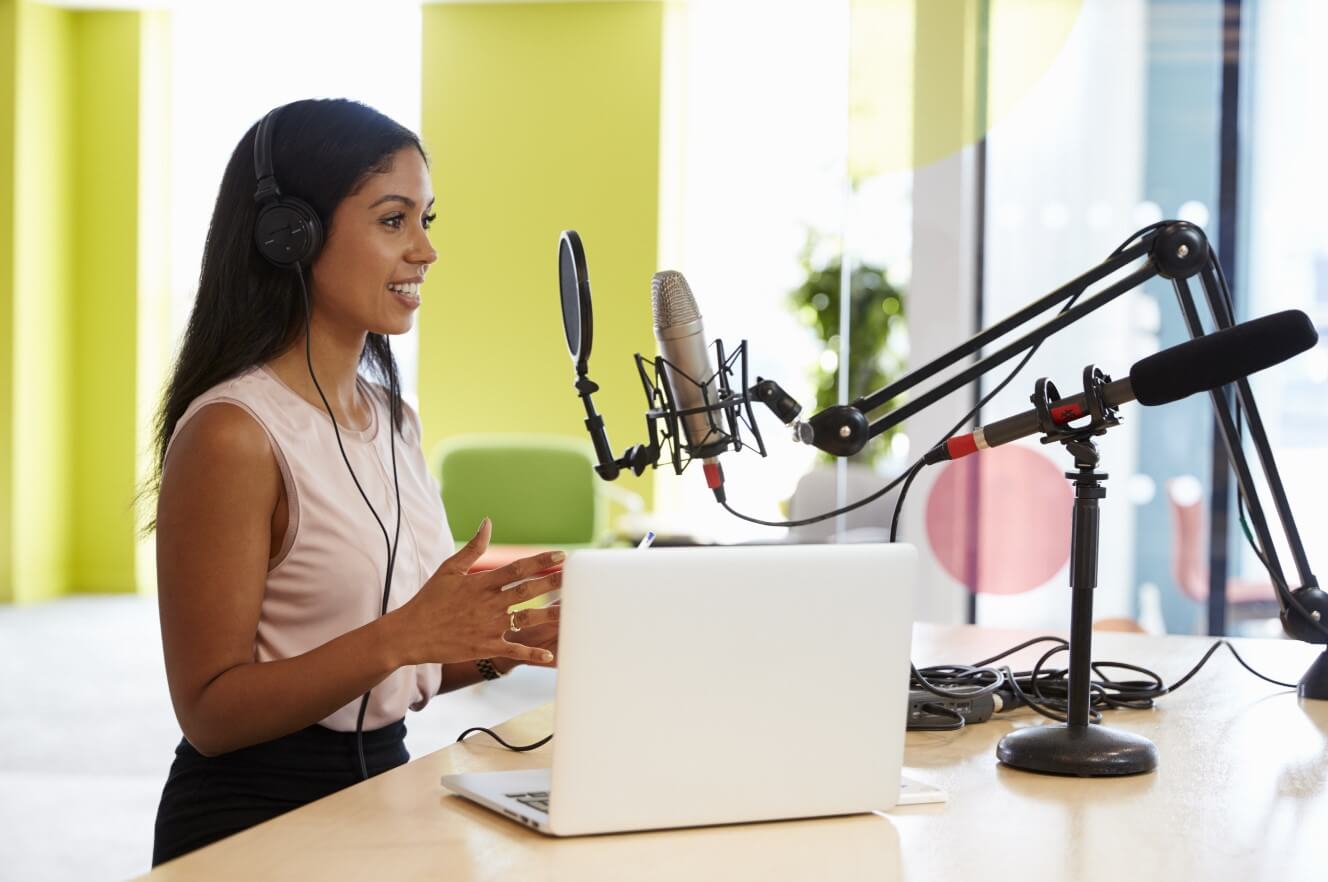Home>Events & Info>Podcast>How To Transcribe Podcast To Text


Podcast
How To Transcribe Podcast To Text
Modified: January 22, 2024
Learn how to transcribe podcast episodes into text format with our step-by-step guide. Convert audio content into written transcripts easily and efficiently.
(Many of the links in this article redirect to a specific reviewed product. Your purchase of these products through affiliate links helps to generate commission for AudioLover.com, at no extra cost. Learn more)
Table of Contents
- Introduction
- Importance of Transcribing Podcasts
- Step 1: Gathering the Necessary Tools
- Step 2: Preparing the Audio File
- Step 3: Choosing Transcription Method
- Step 4: DIY Transcription Techniques
- 1 Manual Transcription
- 2 Speech-to-Text Software
- 3 Using Online Transcription Services
- Step 5: Editing and Proofreading the Transcript
- Step 6: Formatting the Transcript
- Step 7: Supplementing the Transcript with Timestamps or Speaker Labels
- Step 8: Reviewing the Final Transcript
- Conclusion
Introduction
Podcasts have gained immense popularity in recent years as a powerful medium for sharing information, stories, and entertainment. With millions of podcasts available on a wide range of topics, they have become a go-to source for knowledge and inspiration. However, as engaging as podcasts can be, their audio format can pose obstacles for certain individuals, such as those with hearing impairments or those who prefer reading over listening. This is where podcast transcription comes into play.
Transcribing a podcast involves converting the spoken words into written text, making it accessible to a broader audience and providing a textual reference for future use. Whether you are a podcast host or a listener, transcribing podcasts can offer numerous benefits. It allows for better comprehension, easier searching and referencing of specific information, and opens the door for search engine optimization (SEO) opportunities.
In this article, we will explore the different steps involved in transcribing podcasts into text. We will discuss the necessary tools, techniques for transcription, and tips for editing and proofreading the transcript. So, whether you are a podcast creator looking to transcribe your episodes or a podcast enthusiast who wants to transcribe podcasts for personal use, this guide will equip you with the knowledge and tools to transcribe podcasts effectively.
Importance of Transcribing Podcasts
Transcribing podcasts may seem like an additional task, but it offers several significant benefits that make it well worth the effort. Let’s explore why transcribing podcasts is important:
1. Accessibility: By transcribing podcasts, you make them accessible to a broader audience. People with hearing impairments, non-native English speakers, or those in noisy environments can still enjoy and learn from the podcast by reading the transcript.
2. Improved Comprehension: Some people prefer reading over listening. Providing a transcript allows them to grasp the content more effectively, as they can read at their own pace, refer back to the text, and absorb the information more thoroughly.
3. Search Engine Optimization (SEO): Transcribing podcasts can greatly enhance their visibility in search engines. Search engines can’t crawl audio files, but they can index and rank text. By incorporating keywords and important phrases into the transcript, you increase the likelihood of your podcast appearing in search results, attracting more listeners and subscribers.
4. Enhanced User Experience: Offering a transcript alongside your podcast provides an additional option for users to engage with your content. Some people prefer to skim through the transcript to identify specific topics or sections of interest, saving them time and allowing for a more personalized experience.
5. References and Quotes: Transcriptions serve as a valuable resource for listeners who want to refer back to specific points made in the podcast. It allows them to copy quotes, share them on social media, or use them in blog posts, increasing the reach and impact of your podcast.
6. Content Repurposing: Transcribing podcasts opens up opportunities for repurposing the content in various ways. The transcript can serve as the foundation for blog posts, articles, or e-books, saving time and effort in content creation.
7. Collaboration: Transcribing the podcast makes it easier for team members, collaborators, or guest speakers to review and make adjustments if necessary. It ensures that everyone is on the same page and helps maintain accuracy and consistency.
By transcribing your podcasts, you not only increase accessibility but also optimize your content for SEO, better engage with your audience, and create opportunities for repurposing and collaboration. Now that we understand the importance of podcast transcription, let’s delve into the steps required to transcribe a podcast effectively.
Step 1: Gathering the Necessary Tools
Before diving into the transcription process, it is important to gather the necessary tools and resources to ensure a smooth and efficient workflow. Here are some essential tools you will need:
1. High-Quality Headphones: A good pair of headphones is crucial for accurate transcription. Look for headphones that offer clear sound quality and noise isolation to help you hear the podcast audio and pick up subtle nuances or accents.
2. Transcription Software: There is a range of transcription software available that can aid in the transcription process. These software options offer features like audio playback control, speed adjustment, text formatting, and more. Some popular transcription software includes Express Scribe, TranscribeMe, and InqScribe.
3. Text Editing Software: To transcribe podcasts, you will need a text editing software program, such as Microsoft Word, Google Docs, or any other preferred word processing software. This will allow you to efficiently type and format the transcript.
4. Online Transcription Tools: There are also online tools that can assist in transcribing podcasts. These tools use speech recognition technology to automatically convert audio into text. While they may not be as accurate as manual transcription, they can be helpful for initial transcription drafts or for those with basic transcription needs. Examples of online transcription tools include Otter.ai, Happy Scribe, and Temi.
5. Reference Materials: Depending on the topic of the podcast, it may be beneficial to have access to reference materials like industry-specific dictionaries, glossaries, or specialized terminology guides. These resources can help ensure accurate transcription of technical terms or jargon.
6. Time Management Tools: Transcribing podcasts can be time-consuming, so it’s helpful to have time management tools to stay organized and efficient. Consider using task management apps, project management tools, or time tracking software to help you manage your transcription workload effectively.
By gathering these tools, you will be well-equipped to handle the transcription process. As you progress, you might find additional tools or techniques that work best for you, so don’t be afraid to experiment and find what suits your needs. With the necessary tools in hand, you are ready to move on to the next step: preparing the audio file for transcription.
Step 2: Preparing the Audio File
Before you can begin transcribing a podcast, it is important to properly prepare the audio file to ensure optimal clarity and accuracy during the transcription process. Here are some steps to follow when preparing the audio file:
1. Choose a High-Quality Recording: Start with a high-quality audio file for transcription. If you are the podcast creator, ensure that the recording equipment and settings are optimized to capture clear and intelligible audio. If you are transcribing someone else’s podcast, try to obtain the highest quality audio file available, such as a WAV or FLAC file.
2. Remove Background Noise: Background noise can interfere with the transcription process and make it challenging to decipher the spoken words. Use audio editing software, such as Audacity or Adobe Audition, to reduce background noise and enhance the clarity of the audio. Apply noise reduction filters or manually edit out any distracting noises to improve the overall quality of the audio.
3. Normalize the Volume: Audio files often have variations in volume, with some sections being louder or softer than others. Normalize the volume of the audio file to ensure a consistent level of sound throughout. This can be done using audio editing software or specific tools within transcription software.
4. Split the Audio into Smaller Segments: If the podcast episode is long, splitting the audio file into smaller segments can make the transcription process more manageable. Divide the podcast into logical sections, such as by topic or time intervals, to give yourself shorter files to transcribe at a time.
5. Provide Speaker Identification: If there are multiple speakers in the podcast, it is essential to provide speaker identification to differentiate between them in the transcript. Note the names or initials of each speaker and indicate who is speaking at specific points in the audio. This will help maintain clarity and accuracy in the final transcript.
6. Save a Backup of the Original File: It is always a good practice to save a backup copy of the original audio file before making any modifications. This ensures that you can go back to the pristine recording if needed and prevents any accidental loss of data during the preparation process.
By following these steps, you can ensure that the audio file is optimized for transcription, making it easier for you to accurately transcribe the podcast. Once the audio file is prepared, you can proceed to the next step: choosing the transcription method that best suits your needs.
Step 3: Choosing Transcription Method
When it comes to transcribing a podcast, there are various methods you can choose from. The right method for you will depend on factors such as time constraints, budget, accuracy requirements, and personal preference. Here are some popular transcription methods to consider:
1. Manual Transcription: Manual transcription involves listening to the podcast audio and typing out the spoken words into a text document. This method offers the highest level of accuracy and allows for careful editing and proofreading. However, it is time-consuming and requires a strong command of typing skills and attention to detail.
2. Speech-to-Text Software: Speech-to-text software, also known as automatic transcription or voice recognition software, uses advanced algorithms to convert spoken words into written text. This method can save time compared to manual transcription, but it may not always provide perfect accuracy. Popular speech-to-text software includes Dragon NaturallySpeaking, Google Cloud Speech-to-Text, and Apple Dictation.
3. Online Transcription Services: Online transcription services involve outsourcing the transcription work to professional transcribers. These services ensure high-quality transcripts and can save you time and effort. You upload your audio file to the service, and they send you back a transcript within a specified turnaround time. Examples of online transcription services include Rev, Scribie, and GoTranscript.
4. Hybrid Approach: A hybrid approach combines elements of both manual transcription and speech-to-text software. You can use automated transcription software to generate an initial transcript and then manually edit and correct any mistakes or inaccuracies. This method strikes a balance between efficiency and accuracy.
When choosing a transcription method, consider factors such as the complexity of the podcast content, your available time, budget, and the level of accuracy required. It’s important to note that while speech-to-text software and online transcription services can speed up the transcription process, they may not always provide the same level of accuracy as manual transcription.
Ultimately, the choice of transcription method will depend on your specific needs and resources. Experiment with different methods to find the one that suits you best. Once you have chosen a method, you can proceed to the actual transcription process, which we will explore in the next step.
Step 4: DIY Transcription Techniques
If you have chosen to transcribe the podcast yourself, there are several effective DIY transcription techniques you can utilize. These techniques require a combination of focused listening, efficient typing, and attention to detail. Here are some popular DIY transcription techniques:
1. Manual Transcription: This technique involves listening to the podcast audio and typing out the spoken words manually. Ensure that you have a comfortable typing setup and a text editing software program open. Play the audio in short segments, pausing and rewinding as needed to accurately transcribe the content.
2. Transcription Software: Utilize transcription software programs that provide features specifically designed for transcription. These programs allow you to control audio playback speed, set hotkeys for pausing or rewinding, and offer text formatting options. This can enhance your efficiency and accuracy during the transcription process.
3. Shortcut Keys and Hotkeys: Familiarize yourself with shortcut keys and hotkeys for frequently used functions such as play, pause, rewind, and fast forward in your transcription software or text editor. This will help you save time and avoid disruptions to your typing flow.
4. Listen in Short Segments: Break the podcast audio into manageable sections or segments to transcribe more efficiently. After completing each segment, take a short break before moving on to the next one. This allows for better focus and prevents fatigue or loss of concentration.
5. Special Note-taking Techniques: Develop a set of shorthand or abbreviated notes to capture common phrases, keywords, or speaker identification efficiently. This can help speed up your typing while ensuring accuracy and maintaining the context of the conversation.
6. Proofreading and Editing: Once you have transcribed the entire podcast, set aside time for proofreading and editing. Review the transcript for any errors, spelling mistakes, or omissions. Pay attention to punctuation and formatting to ensure readability and coherence.
Remember, DIY transcription requires patience, concentration, and accuracy. Take breaks when needed, maintain good posture to avoid discomfort, and be prepared to invest sufficient time in the process. These techniques will help you achieve accurate and well-formatted transcripts for your podcast.
In addition to these techniques, it is important to stay focused and motivated throughout the transcription process. Find a quiet and comfortable environment, minimize distractions, and set realistic goals and deadlines to ensure steady progress. With dedication and practice, you will become more efficient and skilled at DIY podcast transcription.
1 Manual Transcription
Manual transcription is a labor-intensive but highly accurate method of transcribing podcasts. It involves listening to the podcast audio and typing out the spoken words verbatim. Here are some key considerations and steps to follow for manual transcription:
1. Ensure a Clear Audio File: Use a high-quality audio file without background noise or distortion. If the audio quality is poor, consider enhancing it using audio editing software to improve the clarity and intelligibility.
2. Prepare the Transcription Workspace: Set up a comfortable workstation with a reliable computer, a text editing software program, and a good pair of headphones. Adjust the audio volume to a comfortable level before starting the transcription process.
3. Break the Audio into Segments: Divide the audio file into smaller segments or sections to make the transcription process more manageable. This allows you to focus on one part at a time and reduces the chances of missing out on important details.
4. Listen and Type: Play the audio segment and listen carefully. Type what you hear, aiming for accuracy and capturing the spoken words as precisely as possible. Depending on your transcription speed, you may need to pause, rewind, or replay the audio to ensure accuracy.
5. Use Timestamps: Timestamps are important reference points that indicate the exact time at which certain events or statements occur in the audio. Use them to accurately mark important sections, speaker transitions, or notable moments in the podcast. This will help in the editing and formatting stages of the transcript.
6. Apply Proper Punctuation and Formatting: As you transcribe, ensure that you apply appropriate punctuation and formatting to the text. This includes using paragraph breaks, speaker labels, timestamps, and punctuation marks to maintain readability and clarity in the final transcript.
7. Proofread and Edit: Once you have transcribed the entire podcast, set aside time for proofreading and editing. Review the transcript for any errors, inconsistencies, or misspellings. Check for proper sentence structure, grammar, and punctuation. Make necessary edits to ensure a polished and accurate final transcript.
Manual transcription requires focus, concentration, and attention to detail. It may be time-consuming, especially for longer podcasts, but it provides a high level of accuracy and control over the transcript. With practice, you will become more proficient and efficient, resulting in faster transcription times.
Remember to take breaks when needed and maintain a healthy posture to avoid fatigue. Don’t be discouraged by occasional challenges or difficult portions of the audio. Keep practicing and refining your transcription skills, and you will become adept at accurately transcribing podcasts manually.
2 Speech-to-Text Software
Speech-to-text software, also known as automatic transcription or voice recognition software, utilizes advanced algorithms to convert spoken words into written text. This method offers a faster alternative to manual transcription, although it may not always provide the same level of accuracy. Here are some key points to consider when using speech-to-text software for podcast transcription:
1. Select Reliable Software: Choose a reputable and reliable speech-to-text software program that suits your needs. Popular options include Dragon NaturallySpeaking, Google Cloud Speech-to-Text, Amazon Transcribe, and Microsoft Azure Speech to Text. Research and compare different software packages to find the one that aligns with your requirements.
2. Prepare the Audio: Ensure that you have a clear and high-quality audio file for optimal speech recognition. Remove any background noise and enhance the audio quality using audio editing software if necessary. This will help the software accurately transcribe the spoken words.
3. Train the Software: Some speech-to-text software programs require training to improve accuracy. This involves reading a set of predetermined texts or allowing the software to analyze your voice patterns. Training the software can enhance its ability to recognize and transcribe the audio accurately.
4. Upload the Audio File: Once you have prepared the audio file and trained the software if applicable, upload the audio file to the speech-to-text program. The software will then process the audio and generate a transcript based on its analysis of the spoken words.
5. Edit and Review: After the software generates the initial transcript, it is important to thoroughly review and edit the text. Speech-to-text software can produce errors, especially in complex or noisy audio files. Correct any mistranscribed words, punctuation errors, or formatting issues to improve the accuracy and readability of the final transcript.
6. Consider Multiple Software Options: Don’t be afraid to try different speech-to-text software programs to find the one that suits your needs best. Each software package has its own strengths and weaknesses, and a trial-and-error approach can help you determine which one provides the most accurate results for your specific podcast.
Speech-to-text software can be a time-saving tool for podcast transcription. However, keep in mind that it may not always provide perfect accuracy and may require additional editing and proofreading. Regularly update the software and explore enhancements to improve accuracy over time.
Remember, the quality of the audio file and the clarity of the speakers’ voices will impact the accuracy of the software’s transcription. It is recommended to use speech-to-text software for podcasts with clear audio and well-spoken speakers.
By leveraging the advantages of speech-to-text software and carefully reviewing and editing the generated transcript, you can save time and effort in the transcription process while maintaining a reasonably accurate transcription of your podcast.
3 Using Online Transcription Services
Online transcription services offer a convenient and efficient way to transcribe podcasts with professional accuracy. These services involve outsourcing the transcription work to trained transcribers who can deliver high-quality transcripts within a specified timeframe. Here are some essential points to consider when using online transcription services:
1. Research and Select a Reliable Service: Conduct thorough research to find a reputable online transcription service that suits your specific needs. Consider factors such as turnaround time, pricing options, customer reviews, and the accuracy guarantee provided by the service. Popular online transcription services include Rev, Scribie, GoTranscript, and TranscribeMe.
2. Prepare and Upload the Audio: Before submitting your audio file to the online transcription service, ensure that it is clear and of high quality. Remove background noise and optimize the audio to enhance its clarity. Most online services allow you to upload your audio file directly through their website or provide a file transfer option.
3. Select the Required Transcription Specifications: Specify the type of transcription you need, such as verbatim or edited, and any specific formatting requirements. Indicate the desired speaker identification format and whether timestamps are necessary. Providing clear instructions will ensure that the transcript meets your specific requirements.
4. Review and Proofread the Transcript: Once you receive the transcript from the online transcription service, carefully review and proofread it for accuracy and formatting. Make any necessary edits or corrections to ensure that the final transcript is error-free and aligned with your expectations.
5. Consider Confidentiality and Data Security: Ensure that the online transcription service maintains strict confidentiality and data security measures. Your podcast content may contain sensitive information or intellectual property, so it is crucial to choose a service that has robust privacy protocols in place.
6. Communicate and Provide Feedback: If you have any specific requirements or preferences, communicate them clearly with the online transcription service. Provide feedback on the quality of the transcript and the service itself to help them improve and ensure a satisfactory experience for future endeavors.
Using an online transcription service can save you time and effort, especially for larger projects or when accuracy is of utmost importance. These services generally have experienced transcribers who are adept at handling various accents, jargon, and specialized content.
However, it is important to consider the cost associated with online transcription services, as they typically involve paying per minute of audio or per word. For smaller projects or those on a tight budget, using speech-to-text software or manual transcription may be more cost-effective options.
When deciding on using an online transcription service, weigh the benefits of their expertise and accuracy against your budget and project requirements. Keep in mind that utilizing professional transcription services can be a valuable investment in the quality and accessibility of your podcast’s transcript.
Step 5: Editing and Proofreading the Transcript
Once you have transcribed the podcast, whether through manual transcription or using transcription software or services, it is crucial to allocate time for thorough editing and proofreading of the transcript. This step ensures the accuracy, coherence, and readability of the final transcript. Here are some essential guidelines to follow during the editing and proofreading process:
1. Review for Accuracy: Carefully compare the transcript with the original audio, making any necessary corrections to accurately reflect the spoken words. Pay attention to any misheard words, missed sections, or instances where the transcription may have deviated from the original message.
2. Check Spelling and Grammar: Proofread the transcript for spelling mistakes, typos, and grammar errors. Use grammar tools or online resources to assist in identifying grammar or punctuation issues. Ensure that the transcript is free from sentence structure errors, missing words, or incorrect verb tenses.
3. Ensure Consistency: Maintain consistency throughout the transcript in terms of format, punctuation, and style. Pay attention to aspects like capitalization, speaker identification, timestamps, and paragraph breaks. Consistency enhances the overall readability and professionalism of the transcript.
4. Verify Speaker Identification: If your podcast involves multiple speakers, double-check that the speaker identification is accurate and consistent. Ensure that each speaker is correctly labeled throughout the transcript. This helps readers understand the context and follow the conversation more easily.
5. Improve Readability: Enhance the flow and readability of the transcript by making any necessary adjustments. Break long sentences or paragraphs into shorter, more digestible chunks. Use appropriate punctuation to establish clear sentence structure and rhythm. Consider adding section headings or subheadings to organize the transcript further if needed.
6. Ensure Contextual Coherence: Verify that the transcript remains coherent and maintains the overall context of the podcast. Adjust any sentences or phrases that may be confusing or out of context. Clarify any industry-specific jargon or acronyms where needed to ensure understanding for readers.
7. Proofread Again: After making initial edits, proofread the transcript once more to catch any remaining errors or inconsistencies that may have been missed during the initial review. Reading the transcript aloud or having someone else review it can help identify any missed mistakes.
8. Quality Control: Implement a quality control process if you have a team working on the transcript. Establish guidelines and assign someone to review and approve the final transcript to ensure consistency and accuracy.
By diligently editing and proofreading the transcript, you can eliminate errors, enhance readability, and ensure the highest possible quality for your podcast transcript. Remember that the transcript represents the professional presentation of your content, making it vital to invest time and effort in this crucial step.
Step 6: Formatting the Transcript
Formatting plays a crucial role in making your transcript visually appealing and easily readable. A well-formatted transcript enhances comprehension and ensures a seamless reading experience for your audience. Here is a guide to formatting your podcast transcript:
1. Consistent Style: Establish a consistent style throughout the transcript. Decide on factors such as font type, font size, and line spacing. Use a widely available and readable font like Arial or Times New Roman for optimal legibility.
2. Paragraph Breaks: Break the transcript into paragraphs to improve readability. Start a new paragraph when there is a change in speaker, topic, or when a distinct thought is being expressed. Paragraph breaks create visual separation and help readers navigate through the transcript more easily.
3. Speaker Labels: Use speaker labels to indicate who is speaking in the transcript. You can use initials, full names, or labels such as “Host” or “Guest” to identify speakers. Consistently applying speaker labels makes the conversation more understandable and clarifies the flow of dialogue.
4. Timestamps: If necessary, add timestamps in the transcript at relevant intervals, especially if you plan to reference specific points in the podcast. Timestamps are useful for readers who want to locate specific portions of the audio quickly. Format timestamps consistently, such as [HH:MM:SS] or [00:00:00].
5. Captions or Subtitles: If you plan to use the transcript as captions or subtitles for your podcast video, format them accordingly. Include speaker labels and position the text appropriately on the screen to align with the speakers. Follow industry standards for caption formatting to ensure accessibility and compliance.
6. Font Styling: Use font styling sparingly to emphasize certain words or phrases. Bold or italicize text to draw attention, but avoid overusing these formatting options as it can make the transcript appear cluttered or distracting.
7. Consistent Punctuation: Ensure that punctuation is used consistently and appropriately throughout the transcript. This includes commas, periods, question marks, and quotation marks. Consistent and accurate punctuation enhances readability and clarity.
8. Headers and Footers: Include headers and footers in the transcript if desired. Headers can include the podcast’s title, episode number, and date, while footers may include your podcast’s website or other relevant information. These elements provide additional context and branding for your transcript.
9. Review the Formatting: Once you have formatted the transcript, review it as a whole to ensure consistency and readability. Check for any formatting inconsistencies or errors and make necessary adjustments.
Remember that the overall goal of formatting the transcript is to make it visually appealing and easy to read. Consistency in formatting elements throughout the transcript ensures a professional and polished appearance.
By following these formatting guidelines, you can create a transcript that is visually appealing, well-structured, and enhances the overall user experience for your podcast audience.
Step 7: Supplementing the Transcript with Timestamps or Speaker Labels
Timestamps and speaker labels are valuable additions to a podcast transcript, providing additional context and aiding in navigation and comprehension for readers. By supplementing the transcript with timestamps and speaker labels, you enhance the overall accessibility and usability of the transcript. Here’s how to incorporate these elements effectively:
1. Timestamps: Include timestamps at regular intervals or when notable moments occur in the podcast. Timestamps help readers refer to specific points in the audio quickly and easily. Format timestamps consistently by using a standardized time format, such as [HH:MM:SS] or [00:00:00]. Place the timestamps in brackets or parentheses before or after the corresponding text.
2. Speaker Labels: Assign speaker labels to identify different speakers in the transcript. Use the names or initials of the speakers, or specific labels such as “Host,” “Guest,” or “Moderator.” Consistently indicate speaker changes by placing the label before the spoken text or in a separate line. Speaker labels help readers follow the conversation and understand the flow of dialogue.
3. Formatting Speaker Labels: Format speaker labels to distinguish them visually from the spoken text. You can use bold, italics, or a different font color for speaker labels to make them stand out. Consistency in formatting speaker labels helps readers easily identify who is speaking throughout the transcript.
4. Positioning of Timestamps and Speaker Labels: Decide on the positioning of timestamps and speaker labels in the transcript. You can place them right-aligned or left-aligned, depending on your preference or the visual flow of the transcript. It is important to maintain the chosen positioning consistently throughout the document for readability.
5. Separating Timestamps and Speaker Labels: To improve clarity, consider using different formatting or separators to distinguish timestamps and speaker labels from the spoken text. For example, use brackets or colons to set them apart visually. This separation helps readers easily identify the timestamps and speaker labels within the transcript.
6. Consistency and Accuracy: Ensure consistency and accuracy when inserting timestamps and speaker labels. Double-check the timing of the timestamps and make sure the speaker labels match the corresponding speakers in the audio. Consistency and accuracy in these additions maintain the integrity and usefulness of the transcript.
7. Consider Accessibility: When adding timestamps, speaker labels, or other elements to the transcript, ensure their accessibility. Consider using alt text for images, providing a transcript in a text format compatible with screen readers, or presenting the information in a format that accommodates individuals with visual or hearing impairments. This ensures that your podcast transcript is inclusive and accessible to a wider audience.
By supplementing your transcript with timestamps and speaker labels, you make it easier for readers to navigate and understand the podcast content. These additions enhance the user experience and help readers locate specific information or follow the conversation more efficiently. Remember to maintain consistency and accuracy when incorporating these elements to ensure a clear and cohesive transcript.
Step 8: Reviewing the Final Transcript
Before finalizing your podcast transcript, it is crucial to thoroughly review and ensure its accuracy, clarity, and overall quality. This final step helps you deliver a polished transcript that is ready to be shared with your audience. Here’s how to effectively review the final transcript:
1. Read Aloud: Read the transcript aloud to identify any awkward phrasings, incomplete sentences, or grammatical errors. Reading aloud allows you to catch mistakes that might be missed during silent reading and helps ensure that the transcript flows naturally.
2. Verify Accuracy: Double-check the transcript against the original audio to ensure accuracy and completeness. Pay attention to any missed words, mistranscribed sections, or omitted information. Correct any discrepancies between the transcript and the audio to maintain accuracy.
3. Check for Spelling and Grammar: Proofread the transcript for any spelling errors, typos, or grammar mistakes. Use spelling and grammar tools or enlist the help of a proofreader to catch any overlooked errors. Ensure that the transcript adheres to proper grammar rules and has clear sentence structure.
4. Consistency in Formatting: Review the formatting elements of the transcript, such as font size, font type, paragraph breaks, and speaker labels. Ensure that formatting is consistent throughout the document, providing a professional and well-structured appearance.
5. Verify Timestamps and Speaker Labels: Check that the timestamps and speaker labels accurately correspond to the audio and reflect the conversation in the podcast. Confirm that each speaker is properly identified and that timestamps align with the correct sections in the audio.
6. Finalize Editing: Make any necessary edits based on your review. Correct errors, refine sentence structures, and address any inconsistencies or readability issues in the transcript. Aim for a final version that is clear, concise, and easily understood by your audience.
7. Consider Feedback: If possible, seek feedback from others, such as colleagues or trusted listeners. Incorporate their input and suggestions to further enhance the quality of the transcript. External perspectives can help identify areas for improvement and provide valuable insights.
8. Proofread Once More: After making any final edits, proofread the transcript again. Pay attention to any last-minute errors, formatting inconsistencies, or overlooked details. It’s prudent to have a fresh pair of eyes review the transcript to catch any remaining issues.
By thoroughly reviewing the final transcript, you ensure that it meets the desired quality standards and accurately represents the content of your podcast. A well-reviewed transcript demonstrates professionalism and provides a valuable resource for your audience.
Remember to save a copy of the reviewed transcript as a reference and consider archiving it for future use. This will allow you to easily locate and revisit the transcript whenever necessary.
By following these steps and investing time in reviewing the final transcript, you can confidently disseminate a high-quality, accurate, and engaging transcript for your podcast audience to enjoy.
Conclusion
Transcribing your podcast into text is a valuable step that can greatly enhance its accessibility, searchability, and overall user experience. Whether you choose to transcribe manually, utilize speech-to-text software, or enlist the help of online transcription services, the process of transcription requires careful attention to detail and thorough proofreading. Each step, from gathering the necessary tools to reviewing the final transcript, contributes to the creation of a high-quality transcript.
A well-transcribed podcast offers numerous benefits. It ensures that individuals with hearing impairments or those who prefer reading over listening can still access your content. Transcribing podcasts also improves comprehension, allows for easier searching within the text, increases the potential for search engine optimization (SEO), and opens doors for repurposing and collaboration.
Remember to choose the transcription method that best suits your needs, keeping in mind factors such as accuracy, time constraints, budget, and personal preference. Manual transcription provides the highest level of accuracy, while speech-to-text software and online transcription services offer efficiency and convenience.
Throughout the transcription process, editing and proofreading play crucial roles in ensuring the transcript’s accuracy, clarity, and readability. Proper formatting, supplementation with timestamps and speaker labels, and careful review of the final transcript contribute to its overall quality and user-friendliness.
By transcribing your podcast, you not only make it accessible to a wider audience but also increase its potential for discoverability in search engines. Moreover, the transcript can be repurposed for blog posts, articles, or social media content, extending the reach and impact of your podcast.
In conclusion, podcast transcription is a valuable investment that elevates your content and maximizes its potential reach. Embrace the transcription process, taking advantage of the available tools and techniques to create accurate, engaging, and easily digestible transcripts. Your efforts will pay off by providing a valuable resource for your audience and enhancing the overall impact of your podcast.











